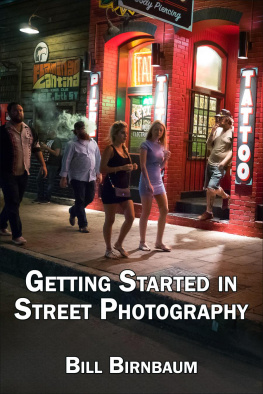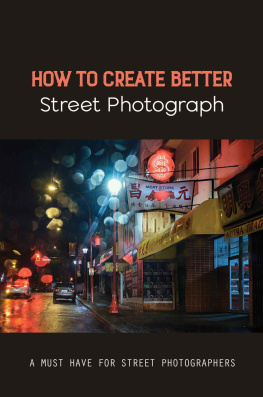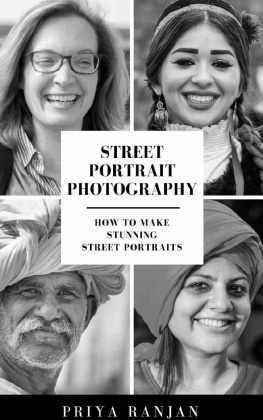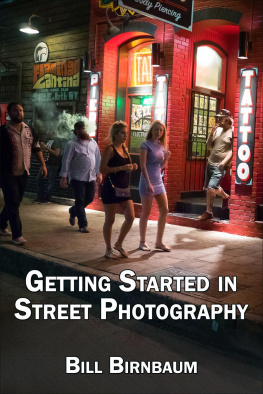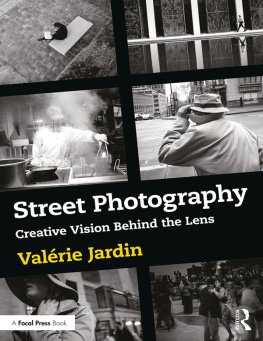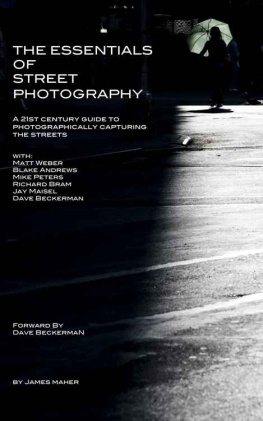Guide
Table of Contents
Getting Started in Street Photography
Bill Birnbaum
Douglas Mountain Publishing
Getting Started in Street Photography
Copyright 2017 William S. Birnbaum
ISBN: 978-1-932632-05-7
All rights reserved. No part of this book may be reproduced or transmitted in any form, electronic or mechanical, including photocopying, recording or by any information storage and retrieval system without the written permission of the publisher.
Table of Contents
()
Introduction
Take a look at the following five photos. What do you think they have in common? Clearly there are many things they do not have in common. As you can see, theyre not all in color. Three are in color and two are in black and white. Nor are they all taken in similar locations. Some I shot outdoors and others indoors. And while four of them are pictures of people, one is absent people. So what do they have in common?
 Window Light
Window Light Oslo, Norway 2014
 Bayside Caf
Bayside Caf Morro Bay, California 2014
 Beer Gal
Beer Gal Austin, Texas 2015
 City Lights
City Lights San Francisco, California 1997
 Clifton Social Club
Clifton Social Club Clifton, Arizona 2016
As you might suspect from the title of this book, all of these images are street photographs. But to accept that all of these images are street photographs, youll have to accept a rather broad definition of street photography. And that brings us to an important question What is street photography?
()
1. What is Street Photography?
In fact, there are many definitions of street photography. If you visit some of the on-line photography forums (DPReviews Documentary and Street Photography forum is one which I especially like) youll read some lively debate on this subject. Some insist that street photographs must be taken on the street that is, on the sidewalks of an urban city. Others suggest that street photography consists of candid photos taken of strangers. Historically, theres some justification for both of these criteria. After all, the large majority (though certainly not all) of early street photographs were candid photos of people who were unknown to the photographer. And the vast majority of those photos were taken on the streets of major cities.
But I feel (and most street photographers seem to agree with me) that these definitions are far too narrow. In fact, a definition which I prefer comes from Wikipedia. The Wikipedia definition calls for an image (which) projects a decidedly human character
 Fine Art
Fine Art San Francisco, California 1997
If you think about this definition for a bit, youll realize that street photography would include images absent people. Like the Fine Art shot above. For though the image is absent a human being, it certainly represents the human character. Specifically, the image depicts the juxtaposition (two contrasting subjects or thoughts) of fine art and trash. Both fine art and trash are objects of humanity representative of the human character.
 Aboard the Train to Lillihammer
Aboard the Train to Lillihammer Norway 2014
This broad definition also includes images shot in environments other than the streets of major cities. Like the above shot of passengers on a train in Norway. And shots taken indoors like inside bars and pubs. And airports. In fact, it might include images shot in any public place, indoors or outdoors.
Im confident that most (though certainly not all) early street photographs were taken outdoors because earlier photographic technologies were unable to record images in low light. After all, to obtain an indoor image in the late 1800s required that the photographer ignite flash powder. Hardly conducive to candid photography. But with todays far more versatile digital camera technologies, the indoor world is as much a part of the street photographers field of operation as is the outdoors.
()
2. Why the Current Interest in Street Photography?
The current popularity of street photography is being driven by technology. In fact, technology is driving such interest in three specific ways. First, the advent of the smart phone has outfitted everyone with a camera in pocket or purse. Our camera ready society goes about its day-to-day activities fully prepared to capture the human character any time, any place. And that day-to-day human character is the essence of street photography.
The second way in which technology is driving increased interest in street photography is that the digital camera has enabled taking pictures for free. Once having purchased a digital camera (or smart phone), the would-be street photographer can then click away at zero cost. No longer having to purchase and develop film, the photographer is free to experiment shooting whatever, whenever, wherever. Much of this whatever, whenever, wherever is the human character street photography.
The third way in which technology is driving interest in street photography is through social media. In fact, social media has been playing an increasingly important role in promoting street photography. Posting images on-line, critiquing images posted by others, plus numerous on-line tutorials all have encouraged many to try their hand at street photography. Search the Internet for street photography and youll see what I mean.
Color vs. Black and White
As street photography dates back to the mid 1800s, well before color film was commercially available (in 1936), early street photographers shot with black and white film exclusively. This tradition of using black and white film continued for quite a long time well into the 1900s. Only toward the mid to late 1900s did some, though certainly not all, street photographers begin shooting with color film. In fact, when I began shooting street photographs in the mid 1990s, I shot exclusively with black and white film. Even in todays era of digital photography, some street photographers still hang onto the old, traditional black and white photo. They shoot either with black and white film (yes, a few still do) or convert color digital to black and white.
In deciding whether to leave a digital image in color or convert to black and white, there are a number of important considerations. Some images are best left in color because color is an important element in that particular image. For example, South Americans love color. In many parts of the continent, not only is clothing very colorful, but so are windows, doors, and much more. To capture this spirit of the culture, black and white simply wont do.

